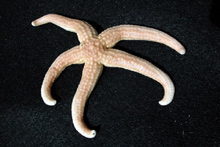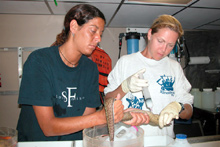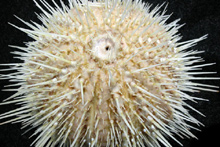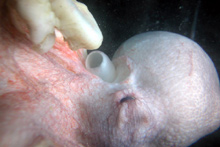
The participating scientists collected invertebrates such as this sea star to analyze back at their onshore laboratories. Photo credit: Art Howard, NAPRO. Click image for larger view.
Making the Cruise Count
August 26, 2003
Martha Nizinski
Zoologist
National Systematics Laboratory
National Marine Fisheries Service
The mission is winding down now, and the scientists are making final requests for specimens, video footage, and digital stills. Even though this morning’s Johnson-Sea-Link II manned submersible dive will be our last opportunity to collect specimens, the work is just beginning. Being at sea to observe, document, and collect is just a small portion, albeit a critical one, of our scientific investigation.
After the mission, members of the science team will return to their home institutions and begin the process of data analysis. The mantra of our mission has been “Make the cruise count." Every piece of information that we can glean from our samples will be incorporated into a scientific, peer-reviewed manuscript.
First, the collections will be sorted. Each collection has associated station data (station number, latitude and longitude, depth, type of gear used, and date) that must stay with the specimens if the collections are to prove be useful. Within the collection from a specific station, the individuals will be sorted to the lowest possible taxonomic level (e.g., family, genus, or species). Using dichotomous keys and comparative material from museum collections or previous expeditions, a member of the scientific crew will identify the specimens to species. In some cases, specimens may be problematic. In such cases, we will consult with other scientists with expertise on that group of organisms. Voucher specimens will be deposited in museum collections when the data collection phase is complete.

Research biologist Tara Casazza and Watch Chief Ann Marie Necaise do the initial workup at sea on a species of moray eel collected via the JSL II. Photo credit: Art Howard, NAPRO. Click image for larger view.
Once the specimens are identified, more data will be collected from individual specimens. The basic biology of many of the organisms we have collected is virtually unknown. Any information we can extract from these specimens will be useful and will add to our working knowledge of the species. These data include morphometric (measurements) and meristic (count) information, size distributions, and sex ratios. Stomach contents will be analyzed for certain species so we can assess “who is eating whom” and describe the trophic dynamics of the ecosystem. Stable isotope samples will be processed and analyzed.
Specimens are just one piece of the puzzle. Hours of videotape and hundreds of digital still photos will be examined. This type of medium allows us to document the presence of organisms that we were not fortunate enough to collect, as well as quantify the abundance and distribution of the reef-associated organisms, describe microhabitat utilization, make behavioral observations in the natural environment, and observe species interactions and associations. Video clips and pictures will be archived for use in publications and presentations.

Invertebrates such as this sea urchin are analyzed in a variety of ways, and the information is incorporated into scientific publications and presentations. Photo credit: Art Howard, NAPRO. Click image for larger view.
Next, the data are analyzed, either qualitatively or quantitatively. These data are then incorporated into scientific publications and presentations. Some publications will report new records, geographical range extensions, or behavioral observations which until now were unknown, while other publications will report our conclusions on the trophic dynamics and community composition of these unique deep-water habitats. Information from previous cruises has already been presented at national and international meetings, including the annual meetings of the American Society of Ichthyologists and Herpetologists, the American Fisheries Society, and the Crustacean Society. Two papers will be presented next month at the Second International Symposium on Deep Sea Corals in Erlangen, Germany.
Our mission has multiple goals, and, as a result, other members of our team will be busy after the ship returns to port. Art Howard, the expedition photographer, has shot about 25 high-definition videotapes (40 min long) and 10 mini-DVD tapes (10 min long), and recorded multiple sound clips. This information will be catalogued and edited to produce a movie for the North Carolina Museum of Natural Sciences. Additionally, the museum will feature this mission and some of Art’s photographs in an upcoming issue of its biannual magazine, North Carolina Naturalist.
Some of the specimens will also be used in the museum's distance-learning classes. Educator-at-sea Doni Angell has written a series of lesson plans about the deep sea and scientific research that will be used in her home school and are available to other teachers. She will present her work at several local education conferences this fall.

This octopus may be shipped to the Smithsonian Institution for detailed analysis. Photo credit: Art Howard, NAPRO. Click image for larger view.
This 12-day mission has been extremely productive and has provided our entire team with the data to meet its research goals. In the upcoming months, as we work with the specimens, watch the video footage, and prepare manuscripts and presentations, we will fondly remember our days at sea exploring the "Life on the Edge."





















